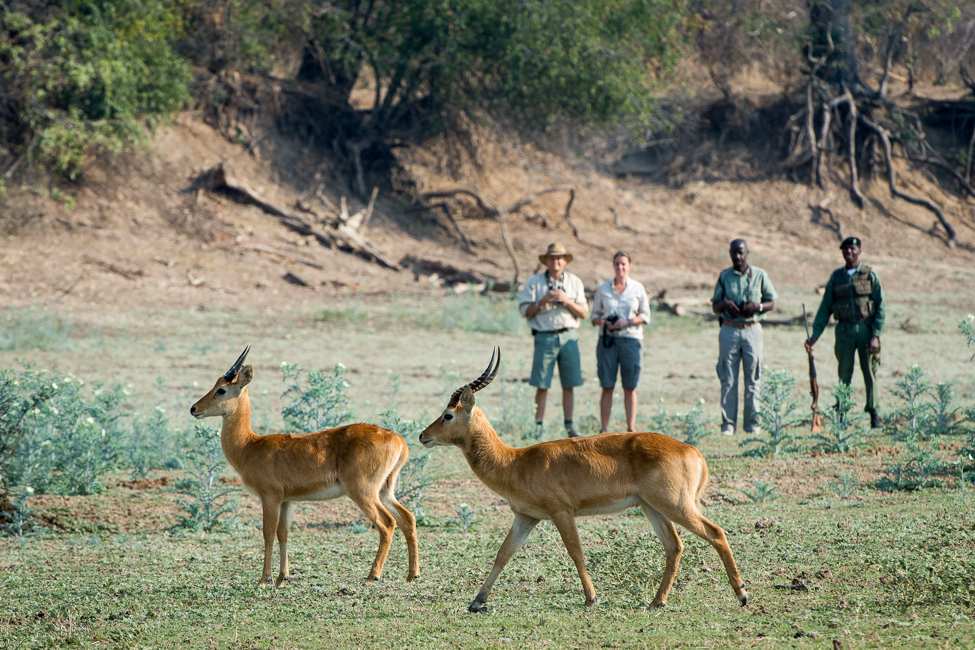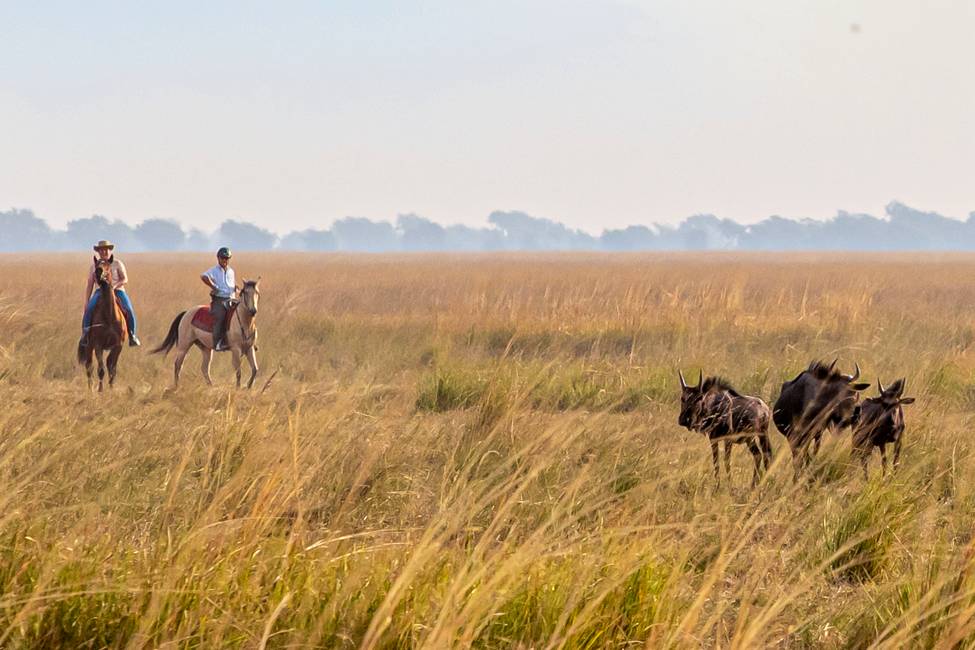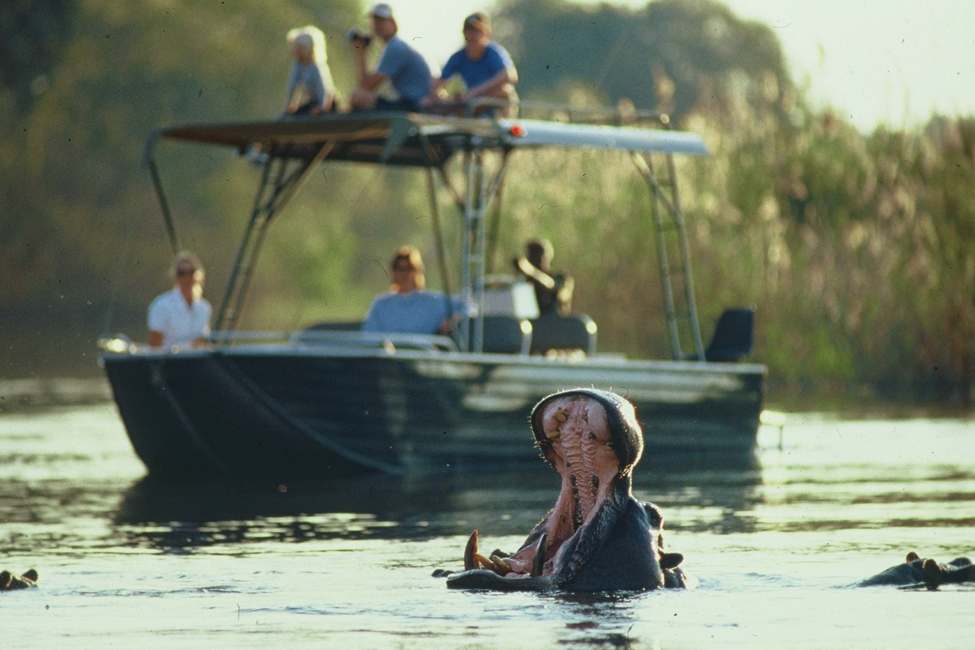South Luangwa National Park in Zambia is known as the home of the walking safari. Photo courtesty Robin Pope Safaris.
Why a Walking Safari Should Be Part of Your African Trip
The word “safari” often evokes images of old-timey explorers traversing Africa’s backcountry on foot. But these days, the most common way to see animals is from the seat of a 4×4 vehicle.
Still, nature hikes and walking safaris remain an incomparable way to explore Africa’s wilds—allowing you to feel the earth beneath your feet and the matchless thrill of viewing Africa’s most iconic wildlife at eye level.
From the vast savannahs of Kenya to the dense jungles of Uganda to the arid landscapes of Namibia, these adventures take you off the beaten path and into areas inaccessible by vehicles.
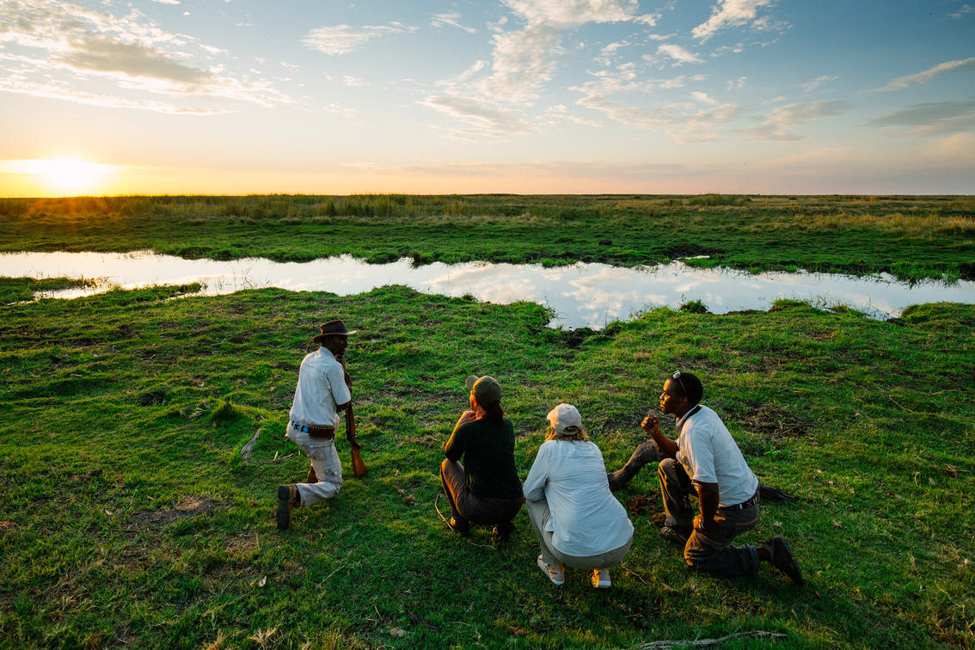
A walking safari at sunset in Chobe Enclave, a private reserve on the Linyanti River near Chobe National Park. Photo courtesy African Bush Camps.
Intimate encounters with nature
Walking safaris in Africa offer a unique perspective, allowing you to see your surroundings in a whole new light. Guided by experienced trackers and rangers, you get an unparalleled opportunity to examine nature up close and notice new sounds, scents, and textures. You may learn to identify a few bird species by their calls or get the chance to smell fragrant plants used medicinally by local communities for centuries. Every step reveals something new and fascinating.
While walking safaris and nature hikes offer a great way to examine the minutiae of your environment—ask your guide to show you the Little Five safari animals—big animals like rhinos, elephants, lions, and zebras are another attraction.
On foot, you can quietly approach animals without disturbing their natural behavior, granting you a front-row seat to some truly extraordinary views. From graceful giraffes grazing on acacia trees to majestic elephants bathing in watering holes, every encounter becomes an unforgettable memory.
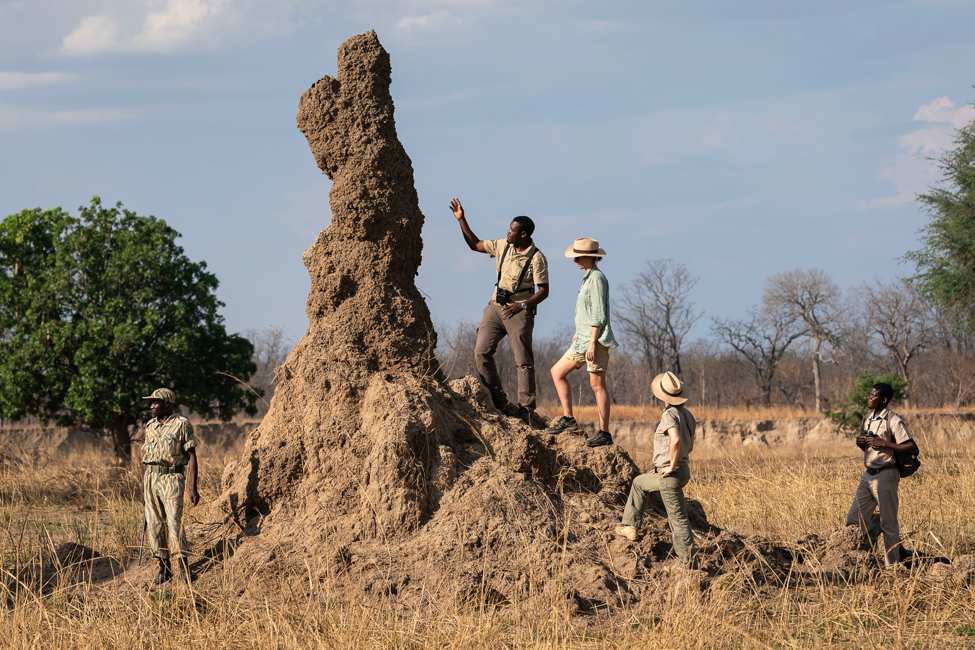
Walking safaris offer a great opportunity to get up close to the landscape. Here, a guide explains the structure of a termite mound in Zambia. Photo courtesy of Robin Pope Safaris.
A good guide is indispensable
On a walking safari, it’s crucial to rely on an experienced guide. In regions where walking safaris may encounter large animals, it is customary for your guide to be armed—though firearms are rarely used and always a last resort.
Instead, guides focus on common-sense safety. They will help you keep a safe distance from larger animals, while still providing you with amazing views. They’ll explain how to behave so animals don’t see you as a threat.
In addition to ensuring your safety, your guide will provide a wellspring of knowledge about the surrounding ecosystem—sharing fascinating stories about animals and showing you how to interpret tracks and other signs left by wildlife. A good guide is truly the most important part of your walking safari.
Bring along some local currency so you can tip your guide for a great job. If you’re not sure how much is appropriate, read our article about tipping on safari.
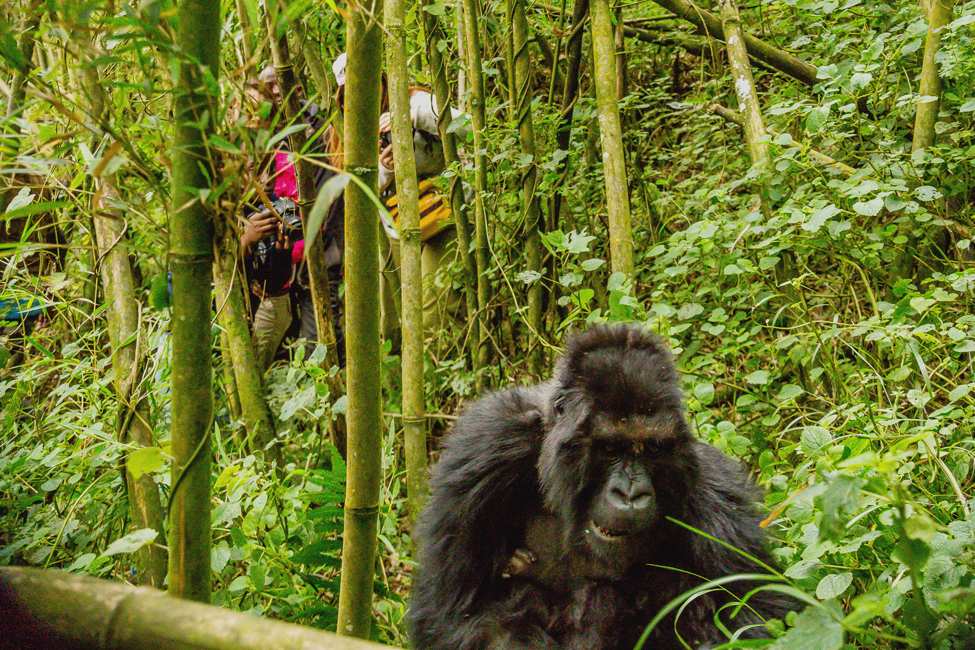
Hikers watch a mountain gorilla at Rwanda’s Volcanoes National Park. Photo by Suresh Thalange, courtesy of Visit Rwanda.
Where vehicles don’t tread
Walking safaris give you access to places a motor vehicle cannot reach, such as remote mountain forests, caves full of rock art, or delicate habitats that would be damaged by large vehicles.
For example, the mountain gorillas in Rwanda’s Volcanoes National Park can only be reached by hiking. Chimp trekking in Rwanda, Tanzania, and Uganda is also done on foot. And in Madagascar, you must get out of the vehicle to see lemurs and explore wilderness areas; most parks are equipped with hiking trails only, not roads.
In Hwange National Park in Zimbabwe, walking safaris are a popular way to track rhinos and elephants. Bush walks in Mozambique’s Gorongosa National Park take visitors off-road to view animal tracks, learn about plants, and look for animals like lions. And to enjoy the petroglyphs (ancient rock art) in South Africa’s Kruger National Park or Namibia’s Twyfelfontein, stepping out of your vehicle is an absolute necessity.
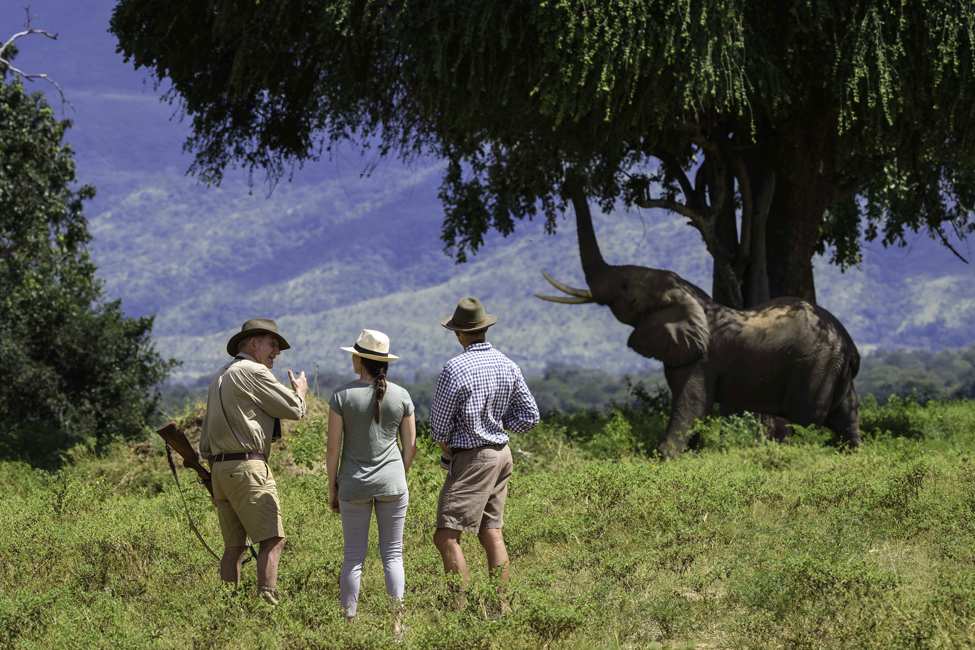
A guide explains the habits of elephants to safari goers on a walking safari in Mana Pools, Zimbabwe. Photo courtesy of John’s Camp.
What to expect on a walking safari
Most walking safaris are not designed to test your fitness. Typically, they take you through parts of a reserve that are easier to traverse and beautiful in their scenery. (However, mountain gorilla treks and other walks in mountainous or hilly areas can be more strenuous.)
On a multi-day walking safari, you’ll trek for a few hours in the morning, and sometimes again in the afternoon, at a steady pace that allows you time to take in your surroundings. You may walk from place to place, staying in a different campsite or lodge each night. Or you may stay at a single lodge while exploring a different route each day.
Of course, multi-day walking safaris are not the only option. You can also include walking as part a safari with game drives and other activities. For example, you can stay at a reserve that offers bush walks in the morning and game drives in the afternoon, or that lets you choose which safari activities you prefer from day to day.
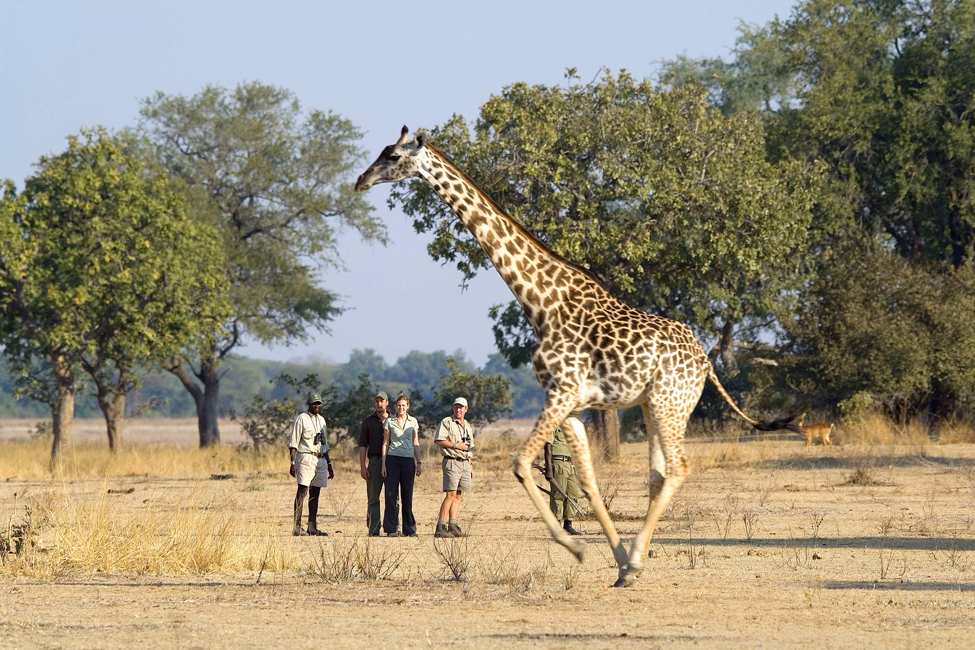
A giraffe speeds by a walking safari in Zambia. Photo by Robin Pope Safaris.
Where to go on a walking safari
Walking safaris are particularly popular in Zambia and Zimbabwe, and are an option in many of those countries’ national parks. In other African countries, walking safaris are more common on private reserves, such as the conservancies around Masai Mara National Park in Kenya.
Check out these sample itineraries for a few places we love to explore on foot:
- Zambia Adventure—One of the top destinations for a walking safari is undoubtedly South Luangwa National Park in Zambia. Renowned for its abundant wildlife population and diverse ecosystems, this park offers excellent opportunities to spot elephants, lions, leopards, and numerous bird species. This 10-night itinerary also includes game viewing by foot in Lower Zambezi.
- Grand Zimbabwe Sample Itinerary—Zimbabwe is famous for its walking safaris. This 12-night itinerary includes a mix of game drives and walks in beautiful Hwange, Matobo and Mana Pools national parks.
- Rwanda—Primate, Birds, and More!—This itinerary includes daily hikes through Rwanda’s Volcanoes and Nyungwe Forest national parks to see gorillas, chimpanzees, and a variety of monkeys, birds, and orchids.
- Legendary Kenya + Zanzibar—This traditional safari includes three days at Ol Pejeta Conservancy—famous for its rhino conservation program and chimp sanctuary—where daily game walks introduce you to a variety of wildlife.
- Madagascar Northern Contrasts & Nosy Be Adventure—Enjoy daily walks through forests and hills to see a variety of lemurs, chameleons, and birds.
- Botswana’s Best Kept Secrets—Explore two very different parts of Botswana’s Okavango Delta by safari vehicle, boat, and foot: the lush floodplains of Khwai Private Reserve and the moonscape of Makgadikgadi Salt Pans. Includes an extension to Victoria Falls.
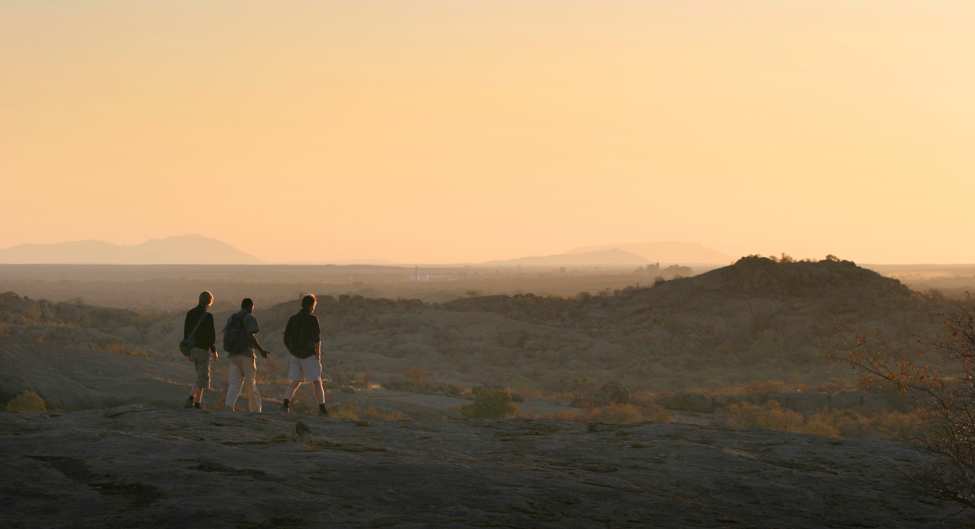
Winter in Damaraland is ideal for walking safaris, where you can look for Namibia’s Little Five safari animals. Photo courtesy of Ai Aiba Lodge.
What to pack for your walking safari
When you travel with Ujuzi, we provide you with a complete list of things to bring along on your safari. The specifics may vary from destination to destination, but in general, you’ll need the following items for a walking safari:
- Sturdy, broken-in hiking boots
- Water shoes or sandals (for wetlands and rainy areas)
- Sunscreen
- Bug repellant
- Sun hat that covers your ears and the back of your neck
Moisture-wicking hiking socks (to prevent blisters) - Waterproof poncho
- Daypack for shorter hikes
- Lightweight, breathable clothing
- Headlamp (if camping or going to caves)
For a more complete list, see our article on packing for safari.
What Ujuzi Travelers Say
It’s very exciting to do a walking safari and know that there is nothing between you and predators. To actually be on foot in the bush and track a lion… it’s amazing.
We stepped down out of the truck and we were ON THE GROUND—no more easy chatter, perched high, comfortable in your seat. We would quietly pick our way through the woodlands, skirting the tall-grass clearings, scanning for movement. Our guide, named Test, and our tracker, Felizardo, gave us an introductory course on interpreting hoof and paw prints, scat, and sound.
We had a small group of four people with the guide, allowing for lots of questions and answers. It was fascinating to learn about identifying animal tracks and exactly how the animal was moving based on the tracks. We also enjoyed learning about the plants and their role in ecosystem, particularly succulents and yellow fever trees.
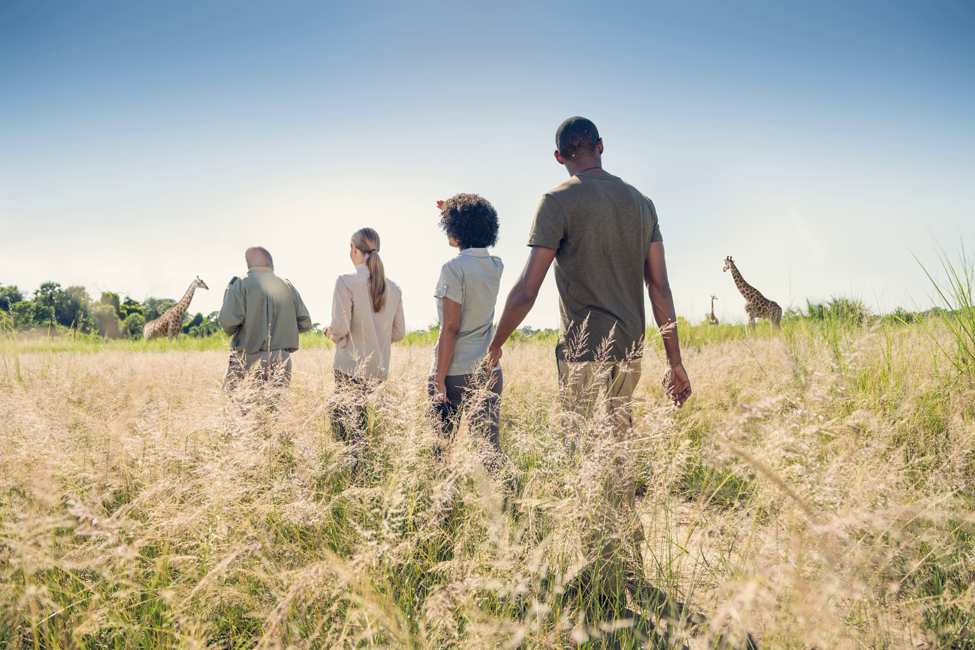
South Africa’s Mpumalanga province, home to Kruger National Park and a number of private reserves, is perfect for walking safaris.
Plan Your Trip
Walking safaris are just one of the many ways to experience Africa. Check out the many other activities you can enjoy on safari.
Ready to explore your safari options? Ujuzi can help you plan your trip throughout.Contact us to make your travel dreams come true.
Sign up for the Ujuzi Newsletter!
From top travel tips to innovative safaris and conservation movement, get inspired to plan your next African safari!
By submitting this form, you are consenting to receive marketing emails from: . You can revoke your consent to receive emails at any time by using the SafeUnsubscribe® link, found at the bottom of every email. Emails are serviced by Constant Contact


